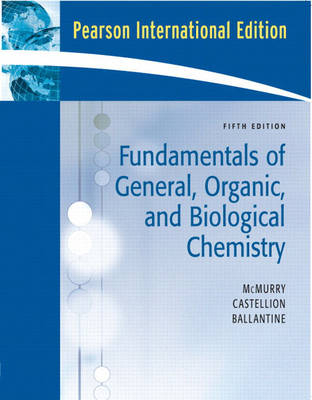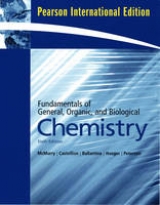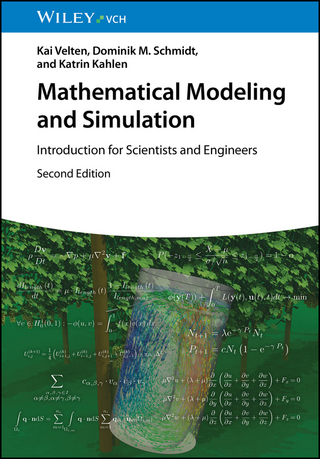
Fundamentals of General, Organic, and Biological Chemistry
Pearson (Verlag)
978-0-13-227995-6 (ISBN)
- Titel erscheint in neuer Auflage
- Artikel merken
Rewritten throughout for enhanced clarity and readability – without sacrificing content – this highly student-oriented best-seller offers a focus on problem-solving and engaging discussions of relevant applications. It effectively covers the essentials of allied health chemistry without excessive and unnecessary detail, and puts chemistry in the context of everyday life. This revision features new co-author David Ballantine.
Chapter 1: Matter and Life
Chapter Goals
Concepts to Review
1.1 Chemistry: The Central Science
1.2 States of Matter
1.3 Classification of Matter
1.4 An Example of a Chemical Reaction
Application: Chemicals, Toxicity and Risk
1.5 Chemical Elements and Symbols
1.6 Elements and the Periodic Table
Application: Mercury and Mercury Poisoning
Keywords
Summary: Revisiting the Chapter Goals
Understanding Key Concepts
Additional Problems
Chapter 2: Measurements in Chemistry
Chapter Goals
Concepts to Review
2.1 Physical Quantities
2.2 Measuring Mass
2.3 Measuring Length and Volume
2.4 Measurement and Significant Figures
Application: Apothecary Units
2.5 Scientific Notation
Application: Powers of Ten
2.6 Rounding Off Numbers
2.7 Problem Solving: Converting a Quantity from One Unit to Another
2.8 Problem Solving: Estimating Answers
2.9 Measuring Temperature
Application: Obesity: A Large Problem
2.10 Energy and Heat
2.11 Density
Application: Measuring Body Fat
2.12 Specific Gravity
Keywords
Summary: Revisiting the Chapter Goals
Understanding Key Concepts
Additional Problems
Chapter 3: Atoms and the Periodic Table
Chapter Goals
Concepts to Review
3.1 Atomic Theory
3.2 Elements and Atomic Number
3.3 Isotopes and Atomic Weight
3.4 The Periodic Table
Application: Are Atoms Real?
3.5 Some Characteristics of Different Groups
Application: The Origin of Chemical Elements
3.6 Electron Structure of Atoms
3.7 Electronic Configurations
3.8 Electronic Configurations and the Periodic Table
Application: Atoms and Light
Connection: Art Conservator
Keywords
Summary: Revisiting the Chapter Goals
Understanding Key Concepts
Additional Problems
Chapter 4: Ionic Compounds
Chapter Goals
Concepts to Review
4.1 Ions
4.2 Periodic Properties and Ion Formation
4.3 Ionic Bonds
4.4 Some Properties of Ionic Compounds
4.5 Ions and the Octet Rule
Application: Minerals and Gems
4.6 Electron-Dot Symbols
4.7 Ions of Some Common Elements
4.8 Naming Ions
Application: Salt
4.9 Polyatomic Ions
Application: Biologically Important Ions
4.10 Formulas of Ionic Compounds
4.11 Naming Ionic Compounds
4.12 H+ and OH- Ions: An Introduction to Acids and Bases
Connection: Physical Therapist
Application: Osteoporosis
Keywords
Summary: Revisiting the Chapter Goals
Understanding Key Concepts
Additional Problems
Chapter 5: Molecular Compounds
Chapter Goals
Concepts to Review
5.1 Covalent Bonds
5.2 Covalent Bonds and the Periodic Table
5.3 Multiple Covalent Bonds
5.4 Coordinate Covalent Bonds
Application: Carbon Monoxide: A Surprising Molecule
5.5 Molecular Formulas and Lewis Structures
5.6 Drawing Lewis Structures
5.7 The Shapes of Molecules
Application: VERY Big Molecules
5.8 Polar Covalent Bonds and Electronegativity
5.9 Polar Molecules
5.10 Naming Binary Molecular Compounds
Application: Damascenone, by Any Other Name, Would Smell as Sweet
5.11 Characteristics of Molecular Compounds
Keywords
Summary: Revisiting the Chapter Goals
Understanding Key Concepts
Additional Problems
Chapter 6: Chemical Reactions: Classification and Mass Relationships
Chapter Goals
Concepts to Review
6.1 Chemical Equations
6.2 Balancing Chemical Equations
6.3 Avogadro’s Number and the Mole
6.4 Gram-Mole Conversions
Application: Did Ben Franklin have Avogadro’s Number? A Ballpark Calculation
6.5 Mole Relationships and Chemical Equations
6.6 Mass Relationships and Chemical Equations
6.7 Percent Yield
6.8 Classes of Chemical Reactions
6.9 Precipitation Reactions and Solubility Guidelines
Application: Gout and Kidney Stones: Problems in Solubility
6.10 Acids, Bases and Neutralization Reactions
6.11 Redox Reactions
Application: Batteries
6.12 Recognizing Redox Reactions
Application: Photography: A Series of Redox Reactions
6.13 Net Ionic Equations
Keywords
Summary: Revisiting the Chapter Goals
Understanding Key Concepts
Additional Problems
Chapter 7: Chemical Reactions: Energy, Rates and Equilibrium
Chapter Goals
Concepts to Review
7.1 Energy and Chemical Bonds
7.2 Heat Changes During Chemical Reactions
7.3 Exothermic and Endothermic Reactions
7.4 Why do Chemical Reactions Occur? Free Energy
Application: Energy from Food
7.5 How do Chemical Reactions Occur? Reaction Rates
7.6 Effects of Temperature, Concentration, and Catalysts of Reaction Rates
7.7 Reversible Reactions and Chemical Equilibrium
Application: Regulation of Body Temperature
7.8 Equilibrium Equations and Equilibrium Constants
7.9 Le Chatelier’s Principle: The Effect of Changing Conditions on Equilibria
Application: Nitrogen Fixation
Keywords
Summary: Revisiting the Chapter Goals
Understanding Key Concepts
Additional Problems
Chapter 8: Gases, Liquids and Solids
Chapter Goals
Concepts to Review
8.1 States of Matter and Their Changes
8.2 Gases and the Kinetic-Molecular Theory
8.3 Pressure
8.4 Boyle’s Law: The Relation between Volume and Pressure
Application: Blood Pressure
8.5 Charles’s Law: The Relation between Volume and Temperature
8.6 Guy-Lussac’s Law: The Relation between Pressure and Temperature
8.7 The Combined Gas Law
8.8 Avogadro’s Law: The Relation between Volume and Molar Amount
8.9 The Ideal Gas Law
8.10 Partial Pressure and Dalton’s Law
Application: Greenhouse Gases and Global Warming
8.11 Intermolecular Forces
8.12 Liquids
8.13 Water: A Unique Liquid
8.14 Solids
8.15 Changes of State
Application: Biomaterials for Joint Replacement
Application: CO2 as an Environmentally Friendly Solvent
Connection: Respiratory Therapist
Keywords
Summary: Revisiting the Chapter Goals
Understanding Key Concepts
Additional Problems
Chapter 9: Solutions
Chapter Goals
Concepts to Review
9.1 Mixtures and Solutions
9.2 The Solution Process
9.3 Solid Hydrates
9.4 Solubility
9.5 The Effect of Temperature on Solubility
9.6 The Effect of Pressure on Solubility: Henry’s Law
9.7 Units of Concentration
Application: Breathing and Oxygen Transport
9.8 Dilution
9.9 Ions in Solution: Electrolytes
9.10 Electrolytes in Body Fluids: Equivalents and Milliequivalents
9.11 Properties of Solutions
Application: Electrolytes, Fluid Replacement, and Sports Drinks
9.12 Osmosis and Osmotic Pressure
9.13 Dialysis
Application: Time-Released Medications
Keywords
Summary: Revisiting the Chapter Goals
Understanding Key Concepts
Additional Problems
Chapter 10: Acids and Bases
Chapter Goals
Concepts to Review
10.1 Acids and Bases in Aqueous Solutions
10.2 Some Common Acids and Bases
10.3 The Bronsted-Lowry Definition of Acids and Bases
10.4 Water as Both an Acid and a Base
10.5 Some Common Acid-Base Reactions
Application: Ulcers and Antacids
10.6 Acid and Base Strength
10.7 Acid Dissociation Constants
10.8 Dissociation of Water
10.9 Measuring Acidity in Aqueous Solutions: pH
10.10 Working with pH
10.11 Laboratory Determination of Acidity
10.12 Buffer Solutions
10.13 Buffers in the Body
Application: Buffers in the Body: Acidosis and Alkalosis
10.14 Acid and Base Equivalents
10.15 Titration
Application: Acid Rain
10.16 Acidity and Basicity of Salt Solutions
Keywords
Summary: Revisiting the Chapter Goals
Understanding Key Concepts
Additional Problems
Chapter 11: Nuclear Chemistry
Chapter Goals
Concepts to Review
11.1 Nuclear Reactions
11.2 The Discovery and Nature of Radioactivity
11.3 Stable and Unstable Isotopes
11.4 Nuclear Decay
Application: Medical Uses of Radioactivity
11.5 Radioactive Half-Life
11.6 Radioactive Decay Series
11.7 Ionizing Radiation
11.8 Detecting Radiation
Application: Irradiated Food
11.9 Measuring Radiation
11.10 Artificial Transmutation
Application: Body Imaging
11.11 Nuclear Fission and Nuclear Fusion
Application: Archaeological Radiocarbon Dating
Connection: Nuclear Medicine Technician
Keywords
Summary: Revisiting the Chapter Goals
Understanding Key Concepts
Additional Problems
Chapter 12: Introduction to Organic Chemistry: Alkanes
Chapter Goals
Concepts to Review
12.1 The Nature of Organic Molecules
12.2 Families of Organic Molecules: Functional Groups
12.3 The Structure of Organic Molecules: Alkanes and Their Isomers
12.4 Drawing Organic Structures
Application: Natural versus Synthetic
12.5 The Shapes of Organic Molecules
12.6 Naming Alkanes
Application: Displaying Molecular Shapes
12.7 Properties of Alkanes
12.8 Reactions of Alkanes
12.9 Cycloalkanes
Application: Petroleum
12.10 Drawing and Naming Cycloalkanes
Keywords
Summary: Revisiting the Chapter Goals
Understanding Key Concepts
Additional Problems
Chapter 13: Alkenes, Alkynes and Aromatic Compounds
Chapter Goals
Concepts to Review
13.1 Alkenes and Alkynes
13.2 Naming Alkenes and Alkynes
13.3 The Structure of Alkenes: Cis-Trans Isomerism
13.4 Properties of Alkenes and Alkynes
13.5 Kinds of Organic Reactions
Application: The Chemistry of Vision
13.6 Reactions of Alkenes and Alkynes
13.7 How an Alkene Addition Reaction Occurs
13.8 Alkene Polymers
13.9 Aromatic Compounds and the Structure of Benzene
Application: Polycyclic Aromatic Hydrocarbons and Cancer
13.10 Naming Aromatic Compounds
13.11 Reactions of Aromatic Compounds
Application: Why We See Color
Keywords
Summary: Revisiting the Chapter Goals
Understanding Key Concepts
Additional Problems
Chapter 14: Some Compounds with Oxygen, Sulfur, or a Halogen
Chapter Goals
Concepts to Review
14.1 Alcohols, Phenols and Ethers
14.2 Some Common Alcohols
14.3 Naming Alcohols
14.4 Properties of Alcohols
14.5 Reactions of Alcohols
Application: Ethyl Alcohol as a Drug and a Poison
14.6 Phenols
14.7 Acidity of Alcohols and Phenols
Application: Phenols as Antioxidants
14.8 Ethers
14.9 Thiols and Disulfides
Application: Inhaled Anesthetics
14.10 Halogen-Containing Compounds
Application: Chlorofluorocarbons and the Ozone Hole
Connection: Resource Conservationist
Keywords
Summary: Revisiting the Chapter Goals
Understanding Key Concepts
Additional Problems
Chapter 15: Amines
Chapter Goals
Concepts to Review
15.1 Amines
Application: Chemical Information
15.2 Properties of Amines
15.3 Heterocyclic Nitrogen Compounds
Application: NO: A Small Molecule with Big Responsibilities
15.4 Basicity of Amines
Application: Organic Compounds in Body Fluids and the “Solubility Switch”
15.5 Amine Salts
15.6 Amines in Plants: Alkaloids
Application: Toxicology
Keywords
Summary: Revisiting the Chapter Goals
Understanding Key Concepts
Additional Problems
Chapter 16: Aldehydes and Ketones
Chapter Goals
Concepts to Review
16.1 The Carbonyl Group
16.2 Naming Aldehydes and Ketones
Application: Chemical Warfare Among the Insects
16.3 Properties of Aldehydes and Ketones
Application: Vanilla: What Kind Is Best?
16.4 Some Common Aldehydes and Ketones
16.5 Oxidation of Aldehydes
16.6 Reduction of Aldehydes and Ketones
Application: Is it Poisonous, or Isn’t It?
16.7 Addition of Alcohols: Hemiacetals and Acetals
Connection: Sensory Evaluation Manager
Keywords
Summary: Revisiting the Chapter Goals
Understanding Key Concepts
Additional Problems
Chapter 17: Carboxylic Acids and Their Derivatives
Chapter Goals
Concepts to Review
17.1 Carboxylic Acids and Their Derivatives
17.2 Some Common Carboxylic Acids
17.3 Acidity of Carboxylic Acids
Application: Acids for the Skin
Application: Acid Salts as Food Additives
17.4 Reactions of Carboxylic Acids: Ester and Amide Formation
17.5 Aspirin and Other Over-the-Counter Carboxylic Acid Derivatives
17.6 Hydrolysis of Esters and Amides
17.7 Polyamides and Polyesters
Application: Kevlar: A Life-Saving` Polymer
17.8 Phosphoric Acid Derivatives
Keywords
Summary: Revisiting the Chapter Goals
Understanding Key Concepts
Additional Problems
Chapter 18: Amino Acids and Proteins
Chapter Goals
Concepts to Review
18.1 An Introduction to Biochemistry
18.2 Protein Structure and Function: An Overview
18.3 Amino Acids
18.4 Acid-Base Properties of Amino Acids
Application: Nutrition in Health and Disease
18.5 Handedness
18.6 Molecular Handednesss and Amino Acids
18.7 Primary Protein Structure
Application: Proteins in the Diet
18.8 Shape-Determining Interactions in Proteins
Application: Protein Analysis by Electrophoresis
18.9 Secondary Protein Structure
18.10 Tertiary protein Structure
18.11 Quaternary Protein Structure
18.12 Chemical Properties of Proteins
Application: Prions: Proteins that Cause Disease
Connection: Food Technologist
Keywords
Summary: Revisiting the Chapter Goals
Understanding Key Concepts
Additional Problems
Chapter 19: Enzymes and Vitamins
Chapter Goals
Concepts to Review
19.1 Catalysis by Enzymes
19.2 Enzyme Cofactors
19.3 Enzyme Classification
Application: Lead Poisoning and an Antidote
Application: Biocatalysis: Food and Chemicals
19.4 How Enzymes Work
19.5 Effect of Concentration on Enzyme Activity
19.6 Effect of Temperature and pH on Enzyme Activity
Application: Extremozymes: Enzymes from the Edge
19.7 Enzyme Regulation: Feedback and Allosteric Control
Application: Enzymes in Medical Diagnosis
19.8 Enzyme Regulation: Inhibition
19.9 Enzyme Regulation: Covalent Modification and Genetic Control
Application: Enzyme Inhibitors as Drugs
19.10 Vitamins
Application: Vitamins, Minerals, and Food Labels
Keywords
Summary: Revisiting the Chapter Goals
Understanding Key Concepts
Additional Problems
Chapter 20: Chemical Messengers: Hormones, Neurotransmitters, and Drugs
Chapter Goals
Concepts to Review
20.1 Messenger Molecules
20.2 Hormones and the Endocrine System
Application: Homeostasis
20.3 How Hormones Work: Epinephrine and Fight-or-Flight
20.4 Amino Acid Derivatives and Polypeptides as Hormones
20.5 Steroid Hormones
Application: Plant Hormones
20.6 Neurotransmitters
20.7 How Neurotransmitters Work: Acetylcholine, Its Agonists and Antagonists
20.8 Histamine and Antihistamine
Application: And from This Little Frog…
20.9 Serotonin, Norepinephrine, and Dopamine
20.10 Neuropeptides and Pain Relief
20.11 Drug Discovery and Drug Design
Keywords
Summary: Revisiting the Chapter Goals
Understanding Key Concepts
Additional Problems
Chapter 21: The Generation of Biochemical Energy
Chapter Goals
Concepts to Review
21.1 Energy and Life
21.2 Energy and Biochemical Reactions
Application: Life Without Sunlight
21.3 Cells and Their Structure
21.4 An Overview of Metabolism and Energy Production
21.5 Strategies of Metabolism: ATP and Energy Transfer
21.6 Strategies of Metabolism: Metabolic Pathways and Coupled Reactions
Application: Basal Metabolism
21.7 Strategies of Metabolism: Oxidized and Reduced Coenzymes
21.8 The Citric Acid Cycle
21.9 The Electron-Transport Chain and ATP Production
Application: Energy Undone: Blockers and Uncouplers of Oxidative Phosphorylation
21.10 Harmful Oxygen By-Products and Antioxidant Vitamins
Application: Plants and Photosynthesis
Keywords
Summary: Revisiting the Chapter Goals
Understanding Key Concepts
Additional Problems
Chapter 22: Carbohydrates
Chapter Goals
Concepts to Review
22.1 An Introduction to Carbohydrates
22.2 Handedness of Carbohydrates
22.3 The D and L Families of Sugars: Drawing Sugar Molecules
Application: Chirality Meets the Marketplace
22.4 Structure of Glucose and other Monosaccharides
Application: Carbohydrates in the Diet
22.5 Some Important Monosaccharides
22.6 Reactions of Monosaccharides
22.7 Disaccharides
Application: Cell Walls: Rigid Defense Systems
22.8 Variations on the Carbohydrate Theme
22.9 Some Important Polysaccharides
Application: Cell-Surface Carbohydrates and Blood Type
Application: Dietary Fiber
Keywords
Summary: Revisiting the Chapter Goals
Understanding Key Concepts
Additional Problems
Chapter 23: Carbohydrate Metabolism
Chapter Goals
Concepts to Review
23.1 Digestion of Carbohydrates
23.2 Glucose Metabolism: An Overview
23.3 Glycolosis
23.4 Entry of Other Sugars into Glycolosis
23.5 The Fate of Pyruvate
Application: Tooth Decay
Application: Microbial Fermentations: Ancient and Modern
23.6 Energy Output in Complete Catabolism of Glucose
23.7 Regulation of Glucose Metabolism and Energy Production
23.8 Metabolism in Fasting and Starvation
23.9 Metabolism in Diabetes Mellitus
Application: Diagnosis and Monitoring of Diabetes
23.10 Glycogen Metabolism: Glycogenesis and Glycogenolysis
Application: The Biochemistry of Running
23.11 Gluconeogenesis: Glucose from Noncarbohydrates
Application: Polysaccharides–What Are They Good For?
Connection: Dietitian
Keywords
Summary: Revisiting the Chapter Goals
Understanding Key Concepts
Additional Problems
Chapter 24: Lipids
Chapter Goals
Concepts to Review
24.1 Structure and Classification of Lipids
24.2 Fatty Acids and Their Esters
Application: Lipids in the Diet
24.3 Properties of Fats and Oils
24.4 Chemical Reactions of Triacylglycerols
Application: Detergents
24.5 Cell Membrane Lipids: Phospholipids and Glycolipids
24.6 Cell Membrane Lipids: Cholesterol
24.7 Structure of Cell Membranes
Application: Butter and Its Substitutes
Application: Liposomes form Health and Beauty
24.8 Transport Across Cell Membranes
24.9 Eicosanoids: Prostaglandins and Leukotrienes
Keywords
Summary: Revisiting the Chapter Goals
Understanding Key Concepts
Additional Problems
Chapter 25: Lipid Metabolism
Chapter Goals
Concepts to Review
25.1 Digestion of Triacylglycerols
25.2 Lipoproteins for Lipid Transport
Application: Lipids and Atherosclerosis
25.3 Triacylglycerol Metabolism: An Overview
Application: Fat Storage: A Good Thing or Not?
25.4 Storage and Mobilization of Triacylglycerols
25.5 Oxidation of Fatty Acids
25.6 Energy from Fatty Acid Oxidation
25.7 Ketone Bodies and Ketoacidosis
Application: The Liver, Clearinghouse for Metabolism
25.8 Biosynthesis of Fatty Acids
Keywords
Summary: Revisiting the Chapter Goals
Understanding Key Concepts
Additional Problems
Chapter 26: Nucleic Acids and Protein Synthesis
Chapter Goals
Concepts to Review
26.1 DNA, Chromosomes and Genes
26.2 Composition of Nucleic Acids
26.3 The Structure of Nucleic Acid Chains
26.4 Base Pairing in DNA: The Watson-Crick Model
26.5 Nucleic Acids and Heredity
Application: Viruses and AIDS
26.6 Replication of DNA
26.7 Structure and Function of RNA
26.8 Transcription: RNA Synthesis
26.9 The Genetic Code
26.10 Translation: Transfer RNA and Protein Synthesis
Application: “Bird Flu”: The Next Epidemic?
Keywords
Summary: Revisiting the Chapter Goals
Understanding Key Concepts
Additional Problems
Chapter 27: Genomics
Chapter Goals
Concepts to Review
27.1 Mapping the Human Genome
27.2 A Trip Along a Chromosome
Application: Whose Genome is it?
27.3 Mutations and Polymorphisms
27.4 Recombinant DNA
Application: Serendipity and the Polymerase Chain Reaction
Application: DNA Fingerprinting
27.5 Genomics: Using What We Know
Connection: Forensic Scientist
Keywords
Summary: Revisiting the Chapter Goals
Understanding Key Concepts
Additional Problems
Chapter 28: Protein and Amino Acid Metabolism
Chapter Goals
Concepts to Review
28.1 Digestion of Proteins
28.2 Amino Acid Metabolism: An Overview
28.3 Amino Acid Catabolism: The Amino Group
28.4 The Urea Cycle
Application: Pathways to Gout
28.5 Amino Acid Catabolism: The Carbon Atoms
Application: The Importance of Essential Amino Acids and Effects of Deficiencies
28.6 Biosynthesis of Nonessential Amino Acids
Keywords
Summary: Revisiting the Chapter Goals
Understanding Key Concepts
Additional Problems
Chapter 29: Body Fluids
Chapter Goals
Concepts to Review
29.1 Body Water and Its Solutes
29.2 Fluid Balance
29.3 Blood
29.4 Plasma Proteins, White Bloods Cells and Immunity
Application: The Blood-Brain Barrier
29.5 Blood Clotting
29.6 Red Blood Cells and Blood Gases
29.7 The Kidney and Urine Formation
29.8 Urine Composition and Function
Application: Automated Clinical Laboratory Analysis
Connection: Veterinary Lab Technician
Keywords
Summary: Revisiting the Chapter Goals
Understanding Key Concepts
Additional Problems
Appendices
Glossary
Answers to Selected Problems
Photo Credits
Index
| Erscheint lt. Verlag | 27.4.2006 |
|---|---|
| Sprache | englisch |
| Maße | 216 x 277 mm |
| Gewicht | 1888 g |
| Themenwelt | Naturwissenschaften ► Chemie |
| ISBN-10 | 0-13-227995-9 / 0132279959 |
| ISBN-13 | 978-0-13-227995-6 / 9780132279956 |
| Zustand | Neuware |
| Informationen gemäß Produktsicherheitsverordnung (GPSR) | |
| Haben Sie eine Frage zum Produkt? |
aus dem Bereich



